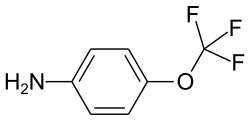4-Trifluormethoxyanilin
4-Trifluormethoxyanilin ist eine chemische Verbindung des Fluors aus der Gruppe der Anilinderivate.
| Strukturformel | |||||||||||||||||||
|---|---|---|---|---|---|---|---|---|---|---|---|---|---|---|---|---|---|---|---|
 | |||||||||||||||||||
| Allgemeines | |||||||||||||||||||
| Name | 4-Trifluormethoxyanilin | ||||||||||||||||||
| Andere Namen |
| ||||||||||||||||||
| Summenformel | C7H6F3NO | ||||||||||||||||||
| Kurzbeschreibung |
gelbe Flüssigkeit[1] | ||||||||||||||||||
| Externe Identifikatoren/Datenbanken | |||||||||||||||||||
| |||||||||||||||||||
| Eigenschaften | |||||||||||||||||||
| Molare Masse | 177,12 g·mol−1 | ||||||||||||||||||
| Aggregatzustand |
flüssig[1] | ||||||||||||||||||
| Dichte |
1,32 g·cm−3 (20 °C)[1] | ||||||||||||||||||
| Siedepunkt |
73–75 °C (13 hPa)[1] | ||||||||||||||||||
| Brechungsindex |
1,463 (20 °C)[1] | ||||||||||||||||||
| Sicherheitshinweise | |||||||||||||||||||
| |||||||||||||||||||
| Toxikologische Daten | |||||||||||||||||||
| Soweit möglich und gebräuchlich, werden SI-Einheiten verwendet. Wenn nicht anders vermerkt, gelten die angegebenen Daten bei Standardbedingungen. Brechungsindex: Na-D-Linie, 20 °C | |||||||||||||||||||
Gewinnung und Darstellung
4-Trifluormethoxyanilin kann aus dem entsprechenden Amid durch einen Hofmannschen Amidabbau gewonnen werden.[2]
Eigenschaften
4-Trifluormethoxyanilin ist eine gelbe Flüssigkeit.[1]
Verwendung
4-Trifluormethoxyanilin kann als Zwischenprodukt für die Herstellung von Pharmazeutika und Agrochemikalien verwendet werden.[3]
Literatur
- M. Tugnait, E. M. Lenz, P. Phillips, M. Hofmann, M. Spraul, J. C. Lindon, J. K. Nicholson, I. D. Wilson: The metabolism of 4-trifluoromethoxyaniline and [13C]-4-trifluoromethoxyacetanilide in the rat: detection and identification of metabolites excreted in the urine by NMR and HPLC-NMR. In: J Pharm Biomed Anal. 28, 2002, S. 875–885, PMID 12039629.
Einzelnachweise
- Datenblatt 4-(Trifluoromethoxy)aniline, 98% bei Sigma-Aldrich, abgerufen am 12. November 2021 (PDF).
- Andrei A. Gakh, Kenneth L. Kirk: Fluorinated Heterocycles. American Chemical Society, 2009, ISBN 978-0-8412-6953-8, S. 308 (eingeschränkte Vorschau in der Google-Buchsuche).
- Thomas A. Unger: Pesticide Synthesis Handbook. William Andrew, 1996, ISBN 0-8155-1853-6, S. 1051 (eingeschränkte Vorschau in der Google-Buchsuche).
This article is issued from Wikipedia. The text is licensed under Creative Commons - Attribution - Sharealike. The authors of the article are listed here. Additional terms may apply for the media files, click on images to show image meta data.


